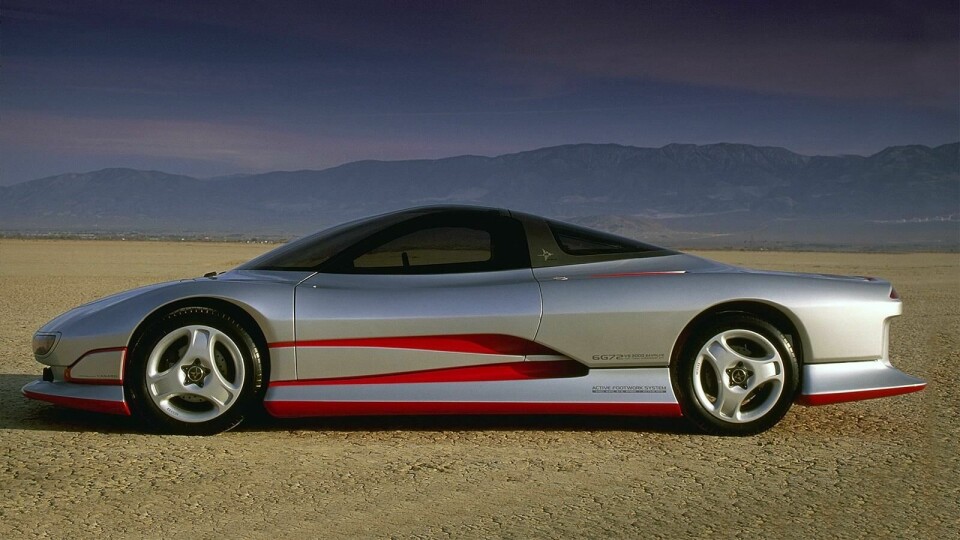
CCotW: Mitsubishi HSR II (1989)
The Mitsubishi HSR II was a concept car from the 1980s that seemed ready for the 2020s
In the late 1980s Mitsubishi began a series of concept explorations called the HSR (Highly Sophisticated-transport Research vehicle) series, meant to be a showcase for advanced Mitsubishi driving and vehicle technologies. The cars were presented every two years to coincide with the Tokyo Motor show, beginning in 1987 and continuing for a decade. The six cars released were all two-seat coupés.

The original HSR. Sleek, organic, high-tech design, with aircraft-style canopy
The first car, introduced in Tokyo in 1987, was named simply the HSR. It featured a sleek organic form that was said to be inspired by the shape of dolphins. Aerodynamics, already in vogue at the time as a symbol of advanced engineering and styling, drove some of the form decisions. The design was meant to marry organic themes with technological sophistication in both design and engineering.

Nazca Hummingbird – inspiration and symbol of the HSR II
The follow-up, presented in Tokyo in 1989, was named the HSR-II. Its form and styling were a further development of the previous HSR. The inspiration for the design (besides the first HSR) was the ancient Nazca carving of a hummingbird found on the high Andean plains in Peru. An image of the winged carving was stenciled on the hood of the HSR II. The sleek body was constructed of Kevlar and composites.

The HSR II featured an advanced system of active aerodynamics
Active aerodynamic elements, introduced on the previous car, found a particular emphasis on the HSR II. The car could vary its coefficient of drag from a remarkably slippery 0.2 to a minivan-like 0.4 for braking. The system was named Active Aero Control and featured canards, flaps, and a chin spoiler, all of which moved around to control the attitude of the car, much like on an aeroplane.

On the rear deck, flaps would open to assist in braking
The chassis was as active as the aerodynamics, with the ‘Active Footwork System’ encompassing four-wheel steering and an integrated control of the full-time four wheel drive, anti-lock brakes, and active electronically-adjusted four-wheel independent suspension to allow for superior driving dynamics.
All this road-hugging wizardry was controlled by OCS-II, an advanced electronic control system made up of seven computers. In addition to attitude control, the OCS-II also managed such functions such as course tracing, automatic vehicle following and parking assist. Sound like Level 4 autonomy? It nearly was.
The engine was a twin-turbocharged three-litre V6 that produced around 350 horsepower – good for a claimed 300km/h (186mph) top speed.

The cockpit-like interior of the HSR II. Note the open canopy which is hinged at the cowl
The interior was accessed through traditional doors and an upswinging bubble-like canopy hinged at the cowl. Once seated, driver and passenger faced an airliner-like array of various electronic displays and instrumentation. A navigation system, an early prototype of a V2V and a V2X communications system, steering and braking assist (linked to the OSCII computer) were also on board. The rear view ‘mirror’ was a camera system that scanned the road behind and projected on a small screen. Again, near-Level 4 autonomy – in 1989.

Mitsubishi’s GTO production car benefitted from HSR experiments
Much of the engineering technologies (though not the driver assists) from the HSR-II would find their way to the Mitsubishi GTO of the 1990s. This was better known in the export markets as the Mitsubishi 3000, and in the US, as the Dodge Stealth. Unique in many ways, the coupé was a mad, but steady presence in Mitsubishi’s lineup throughout the 1990s.

The HSR II lives on virtually in the Gran Turismo series
The HSR II itself would live on in the virtual world, in the video game Gran Turismo (versions 4, 5, PSP and 6), with its active aero system fully functional and oddly entertaining to watch from the ‘chase’ camera view or in replays.

The HSR III. Still sleek, but the design was not as pure
The HSR series continued to move forwards with a new coupé every two years, until the final one in 1997. However, none of the series could match the conceptual purity of the first two cars, or the technical ingenuity of the HSR II.
Roll the HSR II into any modern car show, update its electronic displays, swap in some LED tail lights, and it would be hard to know it was a thirty-year-old car. Its clean design and retro-futuristic bubble top would be quite a crowd pleaser, too. Perhaps Mitsubishi should look to a brilliant concept from the past to model a production car for the future.





